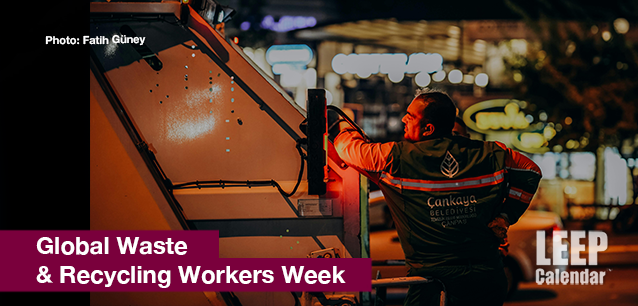 AD
AD
Today is: June 14
Scroll to explore events active on this date.
LEEP INK FEATURES

May Blooms: Events in May 2025
Along with October, May is one of the most densely packed months of the year. It's before the summer humidity and the last whole month of the school year. The weather is warming in t...

Sweet June 2025
The solstice on the 20th marks the onset of summer (Northern Hemisphere) or winter (Southern Hemisphere). Many people, particularly in Europe, North America and Asia, will be embarking o...

Events in April 2025
Spring has sprung in the north, and the first hints of Autumn are on the horizon in the south. April is the month spring (or fall) gets underway, and it is filled with religious celebrations, including the Mu...
About Waste and Recycling Workers Week
Environment Space & The Outdoors
Ends: Jun 21, 2025
DESCRIPTION:
WASTE AND RECYCLING WORKERS WEEK
SHINING A LIGHT ON SANITATION HEROES
Waste and Recycling Workers Week honors the vital, often overlooked contributions of the men and women who keep streets clean, waste managed, and neighborhoods safe.
Founded in 2011 by John D. Arwood, a sanitation industry leader, the event originally began as Global Garbage Man Day. It expanded into a week-long tribute in 2019 to reflect the growing scope of the waste and recycling industry. Today, the observance raises awareness about the demanding nature of the job and promotes appreciation for those who perform it.
Garbage collection is physically grueling and often hazardous. Workers operate heavy machinery, navigate dangerous roadways, are exposed to harmful substances and must work in extreme weather conditions. Yet their work is essential: timely waste removal prevents disease, reduces pollution, and upholds public sanitation—especially in urban areas where even a missed pickup can escalate into a health risk.RAKERS OF LONDON—PIONEERS OF PUBLIC SANITATION
Long before modern garbage trucks and municipal waste systems, London relied on "rakers"—early sanitation workers responsible for clearing the city's growing waste piles. Active as early as the 14th century, rakers were among the first organized efforts to manage urban waste, and their work laid the foundation for modern public health and sanitation services.
The name "raker" comes from their primary tool: a large rake. Rakers cleaned the streets of household refuse, horse manure, ashes, and other debris. In medieval and early modern London, people often dumped waste into the streets, where it would fester, attract vermin, and create noxious odors. Local parishes or wards hired rakers to clear the roads, typically once or twice weekly. They loaded the collected waste into carts and hauled it to designated dumping grounds outside the city, known as "laystalls."
By the Tudor period, London's rakers had become part of a more structured waste management system. In 1543, the English Parliament passed laws requiring householders to keep the area in front of their homes clean and authorized rakers to enforce cleanliness. The growing urban population and increasing waste output made their job both essential and overwhelming.
Rakers often worked at night or early morning to avoid traffic and congestion. Despite their importance, they occupied a low social status, enduring filthy and dangerous conditions. Rakers were exposed to disease, injury, and public disdain, and their work was physically punishing.
By the 18th and 19th centuries, the job of the raker began to evolve with industrialization. As cities modernized, professional municipal services started to replace them. However, their legacy is an early example of organized sanitation in the Western world and a crucial step toward the clean, regulated cities we know today.AMERICA'S WASTE
In 18th-century Philadelphia, Benjamin Franklin initiated one of the first organized garbage collection services. By the 19th century, cities, including London and New York, developed municipal waste systems. Innovations like the rear-loading garbage truck in the 1920s revolutionized efficiency and safety.
Despite these advances, the industry remains male-dominated. As of recent reports, roughly 87% of US garbage collectors are men, with women making up just 13% of the workforce.RECYCLING
Recycling evolved across different cultures. As a concept, recycling dates back thousands of years.
—Greece and Rome recycled and repurposed metals, melting and reusing them because of their high value.
—Japan began paper recycling as early as the 11th century, recognizing the material's scarcity and worth.
Organized recycling on a municipal level emerged in the late 19th century. Notable developments include:
—London, 1860s: "Dust yards" were established to harvest ashes from coal fires for use in other products, including glass, ink, and cement. Workers also separated rags, bones, and metals for reuse or resale.
—New York City, 1895: Became the first US city to mandate recycling, requiring residents to separate household waste into categories: ashes, food waste, and recyclables.
Recycling gained significant traction during World War II when countries promoted recycling as a patriotic duty to support the war effort. Municipalities collected paper, rubber, and metals nationwide.
Curbside collection started in Woodbury, New Jersey, in 1973.
Germany's 1990s strict packaging and recycling laws provided the roadmap for national recycling systems used throughout the world today.RECYCLING BY REGION (2023)
EUROPE
—The European Union averaged 48%
(High) Germany = 69%; (Low) Romania = 12%.
—United Kingdom = 47.9
NORTH AMERICA
—United States = 32%
—Canada = 16% (2022. 2023 numbers not available).
—Mexico = 7.6%
SOUTH AMERICA
—Brazil: 20.6%
ASIA
—Singapore = 52%
—Taiwan = 55%.
—India = 60%
—China = 24.4%
MIDDLE EAST
—Middle East and North Africa (MENA) = 7% to 10%.
OCEANA
—Australia = 63%
AFRICA
—South Africa = 52%
—Rest of Africa = 4%CONCLUSION
Though one of the world's most grueling and physically demanding jobs, sanitation workers often encounter unexpected treasures. Reports include discarded valuables, vintage collectibles, sensitive documents, family heirlooms, and less desirable anomalies.
No matter where you are, take this opportunity to acknowledge and thank those collecting your waste. Waste and Recycling Workers Week pays tribute to the essential workers. They sustain public health and the beauty of our modern life, and their work deserves respect, recognition, and year-round support.
VIDEOS
SUPPORTING DOCUMENTS
Currently, this event does not have supporting documents.
ADDITIONAL IMAGES
Currently, this event does not have supporting images.
Where would you like to go now?
 AD
AD


/footer-logo.svg)
